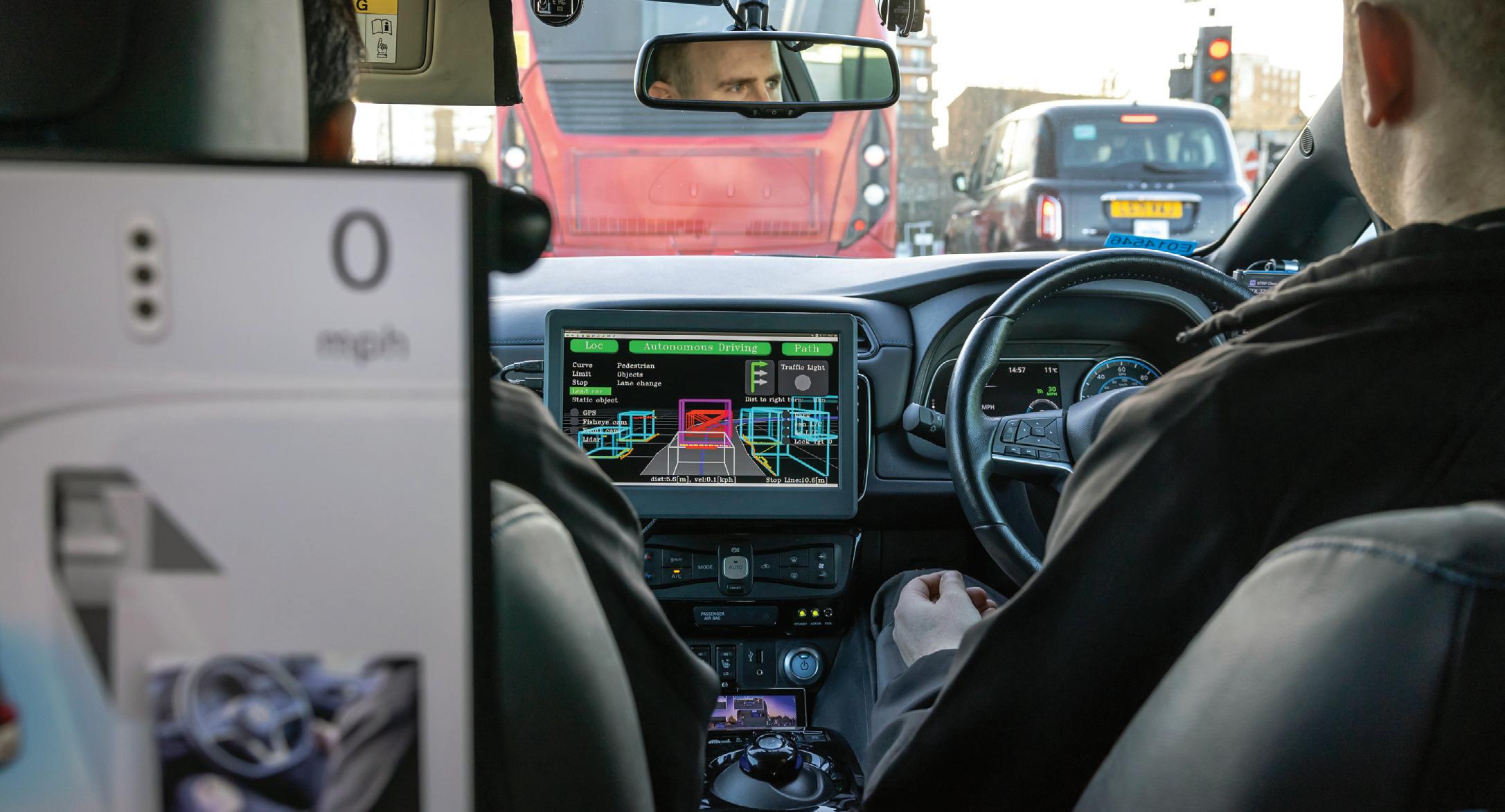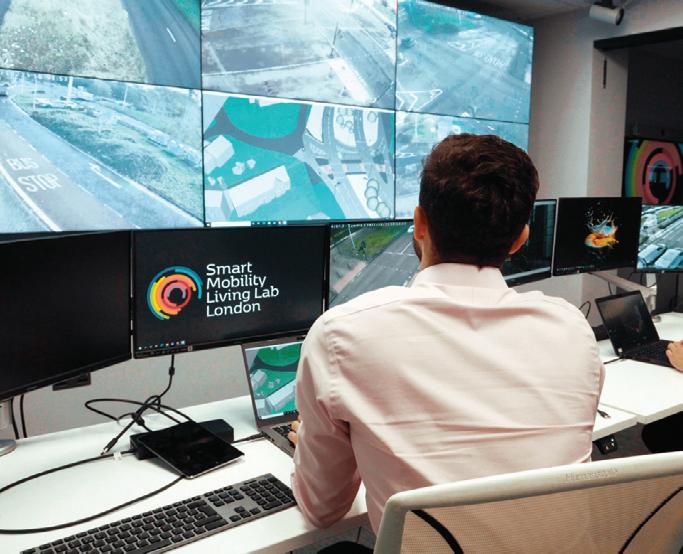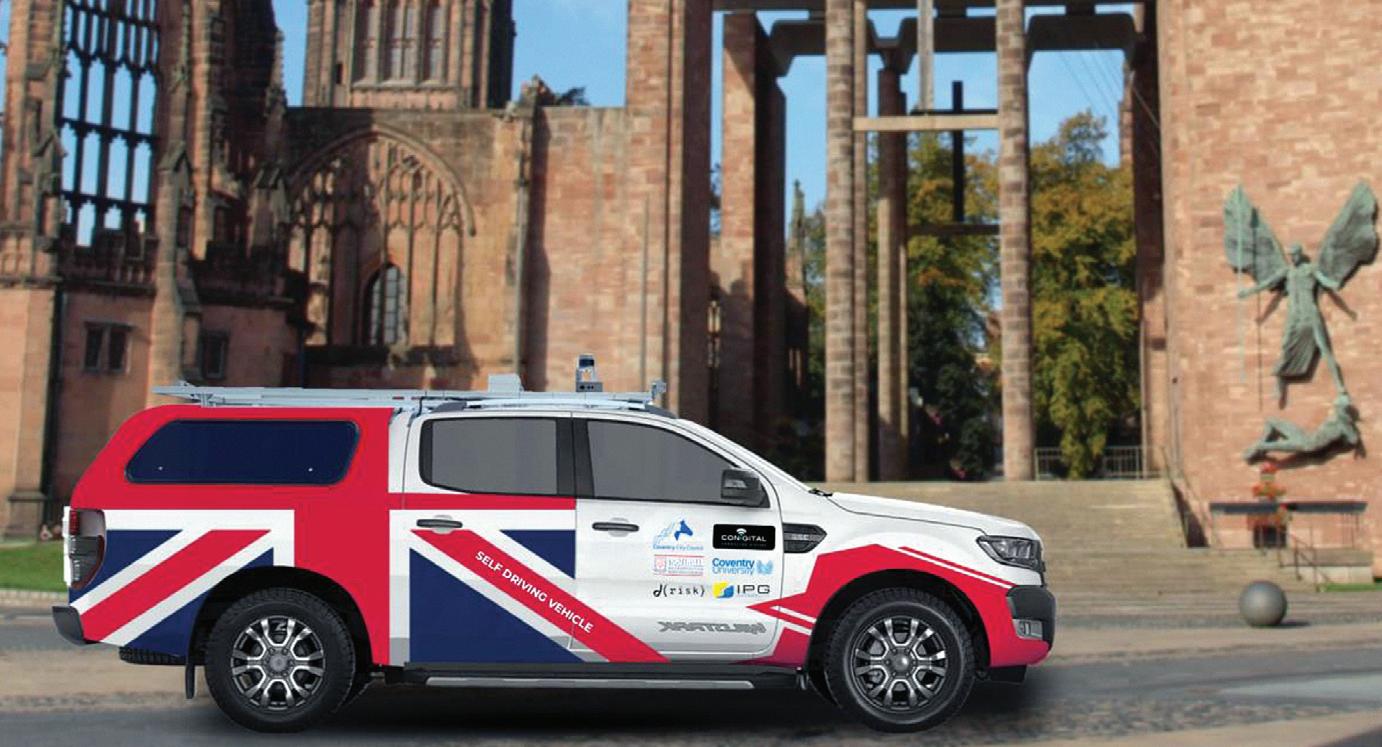
6 minute read
Hailing the dawn of the robotaxi
ServCity AV project ends with electric taxi service in London
ServCity, a UK autonomous mobility service research project, has concluded its final testing phase on the streets of London. For the past three years it has been working to understand how to help cities successfully incorporate autonomous vehicle technologies into a complex urban environment to deliver a ‘robotaxi’ style service, creating a blueprint of the type of infrastructure that will be required to support such technologies.
ServCity is jointly funded by government and industry – the government’s £100m Intelligent Mobility fund administered by the Centre for Connected and Autonomous Vehicles (CCAV) and delivered by Innovate UK.
Six partners – Connected Places Catapult, TRL, Nissan, Hitachi Europe, the University of Nottingham and SBD Automotive – have been collaborating to develop a blueprint that will guide OEMs, transport providers and city planners to get ‘CAV-ready’ in the UK’s cities.


As with other previous CAV development projects backed by government funding, ServCity seeks to give people the confidence that CAVs are safe to introduce onto UK roads. To that end, the finale of the project is a series of demonstrations to stakeholders where guests have been able to experience what an initial deployment of the CAV and CAVready infrastructure technologies might be like. ServCity aims to show that autonomous technology can provide a people-centric mobility service, and which adjustments to the road’s infrastructure are most desirable to make that service the best user experience possible.
Marcel Pooke, sustainability and GIS team lead at Connected Places Catapult said: “Throughout the project Connected Places Catapult has been demonstrating the art of the possible in scaling CAV technologies, and their supporting infrastructure, to help get these vehicles delivering vital services as soon as possible. Based on the potential demand for a CAV service, combined with potential areas of operation, the catapult has helped create a blueprint that provides a basis for follow-on work by many other organisations and aims to assist and enable the full-scale deployment of an operational robotaxi service in a UK city.”
Built upon a 100% electric Nissan LEAF, the ServCity CAV has now successfully completed increasingly challenging validation trials in the realworld environment of TRL’s urban testbed, the Smart Mobility Living Lab (SMLL), based in Greenwich. ServCity was able to leverage the full capabilities of the SMLL, which used its network of roadside sensors and 5G enabled data processing suite to create a futuristic cooperative infrastructure environment, sending new sources of data to the CAV to improve its situational awareness (e.g. alerting the CAV to the intention of an unseen bus to stop ahead).
Thomas Tompkin, head of network
infrastructure and operations of the SMLL said: “ServCity is what the Smart Mobility Living Lab was conceived for – to test emerging technologies safely in a realworld urban testbed and accelerate their commercialisation. We configured our roadside sensor infrastructure and data processing to understand and demonstrate the best ways for CAVs to acquire better shared situational awareness from CAV-ready features within the ITS environment.”
Autonomous drive technology is a key pillar within the Nissan Ambition 2030 business plan. Robert Bateman, manager, Nissan Technical Centre Europe and Nissan project manager for ServCity, said: “Not only has Nissan provided the 100% electric Nissan LEAF as a test vehicle, our talented group of engineers have also contributed to the research and development of cutting-edge autonomous drive technology for use within the project. This has enabled the development of a test vehicle that is able to autonomously navigate the busy streets of London alongside other road users – both stationery and moving – while connected with city infrastructure.”
Nick Blake, chief innovation strategist, Hitachi Europe, said: “The ServCity project has allowed us to further develop the essential technologies needed for urban driving such as the ability to make safe decisions based on advanced situational awareness, and robust localisation in urban canyons – where GPS signals may not be reliable. We’ve made massive strides in the past three years, and we will continue to participate in the autonomous driving revolution.”
Gary Burnett, chair of transport human factors from the Human Factors Research Group at the University of Nottingham, said: “ServCity has supported us to develop novel, human-centred methodologies for designing and evaluating the user experience for future autonomous taxis. Using innovative virtual reality (VR) and field observation methodologies, we have focussed on the inclusive design of interfaces for vehicle occupants and other road users, which deliver a positive user experience in the absence of a human driver.”
Andrew Hart, chief executive at SBD Automotive, said: “Robotaxis have the potential to fundamentally transform mobility for both consumers and the cities they operate in. The user experience lies at the heart of that transformation, as operators will need to carefully balance customer expectations with real-world technological constraints imposed by both vehicles and city infrastructure. The ServCity project has seen theory put into practice, so we are now confident of being able to help carmakers design a seamless robotaxi experience.”
Coventry’s streets to host self-driving cars
MACAM trial goes live in West Midlands
An extensive trial of self-driving technology will take place on the streets of Coventry. The £15.2m MultiArea Connected Automated Mobility (MACAM) Project will begin a trial of self-driving technology within Coventry city centre and at Birmingham’s NEC in around 18 months’ time.

The project is led by Conigital and Coventry University is one of a number of collaborating organisations involved, including Coventry City Council, Solihull Metropolitan Borough Council, Warwick Manufacturing Group, dRisk, IPG Automotive UK, Direct Line Group (insurance) and the NEC.
Coventry University’s role is to develop strategies that provide secure and efficient operation of selfdriving vehicles that can be safely controlled in multiple locations by remote operators in a control room, using a 5G-based, Remote Monitoring and Tele-Operation (RMTO) service.
The university also plans to use the vehicles to operate an internal mail service across its city centre locations, using purpose-built self-driving light vans, while using its expertise in cybersecurity to ensure their safety and reliability.
Initially a driver will be present within the vehicles, but eventually it is anticipated they will be unmanned and monitored completely remotely. Ultimately, the university’s goal from the project is
Law Commission calls for robust regulation
The Law Commission has published advice to government on how to regulate remote driving on UK roads. Remote driving technology, which enables a person to drive a vehicle from a remote location, has seen rapid advancements in recent years, and is already used in controlled environments, such as warehouses and farms.
The Law Commission’s published advice to government is the culmination of a review commissioned by the Department for Transport (DfT) and the Centre for Connected and Autonomous Vehicles (CCAV).
It calls for both short-term changes to the law to respond to emerging safety concerns, as well as a new regulatory regime to govern remote driving on roads in the longer term. The new paper considers remote driving where the driver does not have direct to show that the technology can be put into commercial use.
Kevin Vincent, director of Coventry University’s Centre for Connected and Autonomous Automotive Research, said: “We were chosen to take part in this project because it is recognised that we have expertise in studying human factors and in cyber security in the field of self-driving vehicles.
“Our work on this is all about demonstrating the technology will work in real world settings and providing that evidence for those who want to further develop self-driving technology. Coventry was the site of some of the UK’s early self-driving trials and we have a history of running safe road trials.”
The MACAM Project is one of a number of projects exploring self-driving technology to have recently been awarded a share of £81m in funding from government and private industry as part of the Centre for Connected and Autonomous Vehicles Connected and Automated Mobility programme.
Professor Stewart Birrell, professor of human factors for future transport at Coventry University, said: “There is a defined legal driver of any vehicle but what we’re doing is taking that person out from behind a steering wheel and putting them in a control room. We want to explore the human factors involved and how control of a vehicle is passed over to an operator at specific points in a journey, for example where there may be a particularly difficult section of a trip that needs negotiating. We want to show this technology works within real world settings, not just on a test track.” line of sight of the vehicle and may be in an operations centre many miles away. This could involve the driver using several screens and a control system to direct a vehicle on the road.
Remote driving technology has several potential applications, including delivering rental cars to customers’ doors. The technology may also be used in trials of self-driving vehicles. Whereas most UK trials of self-driving vehicles have an in-vehicle “safety driver”, there is increasing interest in using remote driving technology to enable the safety driver to be located outside the vehicle.
Safety challenges considered in the review include establishing reliable connectivity, driver situational awareness, a possible sense of “detachment” from the physical world, and cybersecurity – such as the threat of a terrorist seizing control of a vehicle.
The commission concludes in its advice that remote driving on roads and public places should only be allowed if companies obtain special permissions









